#finding darwin comic
Text
Somehow, Finding Darwin has updated again, for a third time this week

7 notes
·
View notes
Text
Finding Darwin: Page 35
Read The Whole Comic Here
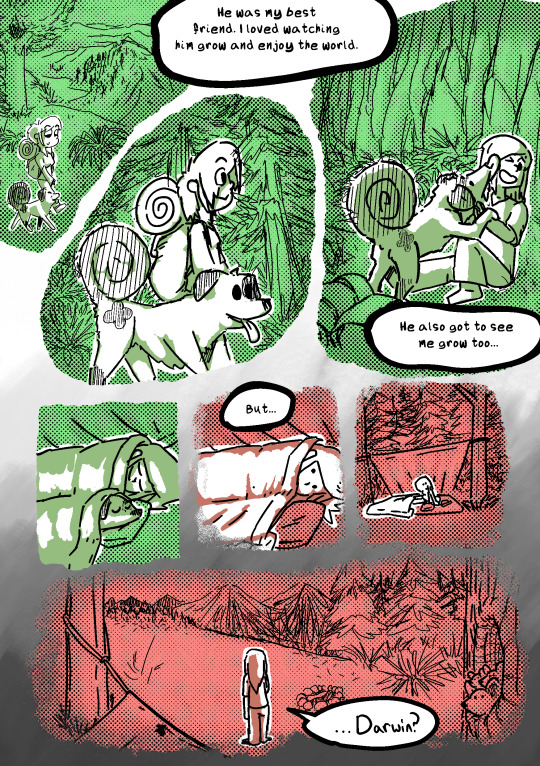
13 notes
·
View notes
Text
Guess who binge read Glass scientists comic...so Hyde in fancy vest because I happened to see @leonenjoyer69 suggestion and love the acting in the comic. It needs an animated show, now.

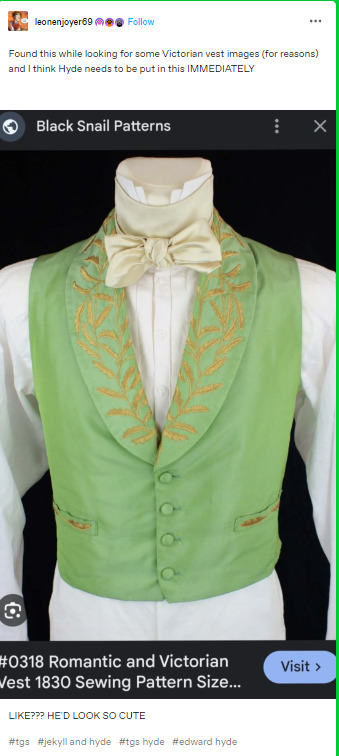
Another week another fandom, it´s not been but three weeks since i binge read dungeon meshi too and it´s all tumbler´s fault!! ahahaha
Funnily enough I´m working on a graphic novel set in 1890s in Santiago de Compostela, with science and weird magical/ local folklore stuff surrounding the story. The main character is a girl obssesed with science and Charles Darwin that completely dismisses the supernatural. Maybe one day I´ll show you a glimpse of her and her wacky little sister XD
The plan is 4 books, I know, how delusional is that? first one is fully drawn and now I´m currently dealing with the inking which is been slow... Color is going to be death.
I´m working towards having it published on my region's dialect/language, and I´ve been weighing out the possibility of sharing an english version online, on a web of it´s own or even tumblr, but I´m really bad at promoting stuff and have no clue about how many of you people that follow this blog will be interested. First part is kinda childish, but it gets darker as the following parts move on, so i donno, if people would stick around. So I guess the only way of finding out is slapping folks with pages as cheese slices slap unsuspecting cats.
#the glass scientists#tgs#jekyll and hyde#tgs hyde#tgs fanart#need the tgs ending so bad...#ramblings#cheese slice slapping cat as marketing strategy
116 notes
·
View notes
Text
A Case for Disney’s “Strange World”
No one seems to know anything about this movie. I didn’t before I saw it yesterday. I went to the movies on a whim and chose this one because the pickings were a bit slim and this one looked like the best out of the bunch.
Guys. This movie is good.
Disney has done this film real dirty by not marketing it properly. I mean, it probably won’t ever take over the world by storm like Encanto did, but it deserves better than what it’s getting. As I said on my Twitter, it is 100% a stunningly beautiful solarpunk film and everyone needs to go see it.
Here’s a brief synopsis since the trailer was garbage and no one saw it anyway:
***The Spoiler-Free Zone***
The story mostly focuses on Searcher, the son of famous explorer Jaeger Clade whose mission in life is to find a passage over the impassable mountains that surrounds their community of Avalonia. While on an expedition to try and scale the peaks, Searcher finds Pando, a mysterious plant that generates a renewable source of electricity. Searcher, tired of exploring and wanting to quit the life, takes the Pando back to Avalonia. Jaeger, still determined to find a way through the mountains, keeps going alone, never to return.
25 years later, Pando has transformed Avalonia into a bustling sci-fi uptopia. Searcher is renowned for having discovered Pando, and now lives a quiet life growing Pando crops with his wife and teenage son. One day, however, the Pando starts dying. In search of a cure, one of Jaeger’s former crew comes to Searcher asking for his help to lead an expedition down underground to figure out what’s killing it and save the society they’ve built with it.
If that sounds like a movie you’d like to see, stop reading now and go see it. Because from here, I’ll be busting out spoilers to talk about themes and why this movie is solarpunk. So I’ll be writing as if you, dear reader, have seen the film.
***The Spoiler Zone***
First of all, this movie is goddamn gorgeous. I really liked the opening comic-panel sequence and all, but I fell in love with the visuals once the story opened up and began showing us Searcher’s farm and Avalonia. Aesthetically, this is about as solarpunk as you can get. Art nouveau-inspired stained glass windows, visible mending on clothes, and really cool-looking tech that’s not at all in conflict with its environment.
That’s not even touching on the world inside Avalonia. I loved the shades of pinks and purples. And the creature design! Absolute chef’s kiss. That whole part of the movie reminded me of this one book I’ve read called ‘Expedition’ by Wayne Douglas Barlowe, which is just about exploring the ecosystem of alien life-forms on a planet called Darwin IV. It’s mostly a collection of really detailed sci-fi paintings of alien creatures. Fantastic stuff. I wouldn’t be surprised at all if someone at the Disney studio had a copy and passed it around for inspiration during production.
In terms of the characters, i thought everyone was engaging and all the voice actors gave really good performances. I really liked Jaeger in particular (yes, he comes back, of course), but all three of the main characters were really well developed.
But, of course, there is The Gay Character. We all know about HIM.
I kid, I kid, I capitalize with irony. They did a good job with him, actually.
I’ve seen a lot of people on Twitter respond to the idea of Ethan Clade with a very cynical shrug without having seen the movie. I have to say, I think people would be genuinely pleased with his portrayal if they gave the movie a chance. There’s no goofy wink-wink LeFou-ing about here. He’s a main character throughout the movie, his love interest is presented upfront with sincerity, and everyone within the world accepts it as normal. He’s not fighting anyone to be gay or trying to hide it, nor is it his one defining trait. He just has a crush on a dude and his dad embarrasses him a bit in front of him. Normal teenage stuff. His character arc is about sorting out his identify in relation to his family, especially his dad. Being gay literally has nothing to do with his character any more than his mom and dad being straight. Which is how it should be.
The story is a fun ride. It’s really well-paced. I was never bored, personally. There are some really great action scenes, some cute comedy with a three-legged dog and a goo creature called Splat, and the emotional beats all made sense with the characters and moved the story forward. It has a lot of qualities that reminded me of Up! and some parts of The Incredibles without directly being a rip-off of either of those. It’s its own thing, and I look forward to being able to watch it again on DVD/streaming.
***I know some of you kept reading anyway so for real, this is where I’m about to get into True Spoilers so save yourselves now y’allllllll***
Ultimately, this is a movie about legacy. Specifically, the legacy we want to leave our children (i.e. those who will come after us). I love the way this movie manages to take the existential crisis we face now in our blessed, beautiful world and condense it into a story where that issue of legacy, of our priorities, and of who we want to be is made clear.
Jaeger Clade is the society that brought us to where we are now. He’s a loud, brash, bush-whacking old man who’s driven to overcome obstacles. Searcher Clade is us now. Not looking to conquer for conquering’s sake, but complacent and only interested in continuing the status quo. He’s proud of what he’s made and sees no reason to change. Ethan Clade is who we should want to be. Someone looking for a third option, who wants to co-exist with the world around them, and be curious without being destructive.
These three outlooks correlate directly to the reveal that Avalonia is actually a living creature, and Pando is a disease that is literally wrapped around the living, beating heart of their world and slowly killing it. It was Jaeger’s drive to explore that led to the discovery of Pando. Searcher was unintentionally making the problem worse by growing more and more Pando to fuel their society. And throughout the movie, everyone is working together to save Pando, and it’s Ethan alone who tries to get them to stop and think more about what they’re looking at, and that things might not be as simple and straight-forward as they appear.
And this is why I think this movie is solarpunk, and not just aesthetically. Obviously, there are direct parallels to our use of fossil fuels, but I think it’s important that in the universe of Strange World, Pando is not an obvious poison or something they have to destructively mine to get. It’s a plant. Something that appears so innocuous at first, but under the surface, grows into a huge, overwhelming problem. No one is an evil bad guy looking to make profit off Pando or keep on destroying the world because it makes them money to do so. Everyone in the movie does what they do because they think they’re doing the right thing. What is the right and wrong answer isn’t always clear, and rather than being a result of them being outright evil, it’s just because they don’t fully understand the consequences.
While I was in the theater watching this, I thought about the Himalayan blackberries that have taken over the Pacific Northwest. It was introduced in the late 1800s by a botanist named Luther Burbank. He prized it for how much produce one blackberry bush could make in a single season, as opposed to the native blackberries that made smaller berries in smaller quantities. His intent was genuinely for the good. He wanted to propagate a crop that could accessibly feed the growing urban areas of the PNW. Create a food forest, in a sense. He sold the seeds because it was easy to grow and would feed people.
Obviously, it’s not bad to want to feed people. But now the damn plant has invested everything, and while the berries are still very much edible (and people do still eat them), it’s also created impenetrable thickets that kill everything around them and interfere with the ability of wildlife to get around. It got out of control. Even though the intent was meant well, the outcome created a problem that is now essentially impossible to overcome. People try anyway, because we have to, but the odds are not in our favor.
Solarpunk isn’t about growing more plants or having more trees in our cities or building solar panels and wind farms everywhere. Well, it’s not JUST that. Of course those things are good things, but every solution offered needs the proper context to work. And that’s the real nature of the movement, right? It’s finding solutions that lead to the best outcomes for everyone. Being invested in our world, learning about it, falling in love with it, discovering the intricacies of how everything is interconnected and how we fit into that. Everything we do will have inevitable impacts on everything around us, but what those impacts are can change radically depending on how carefully we consider our actions. We know we have to change. The question is, how do we change? How do we change for everyone?
And that is the ending message of the film. The heroes choose to save Avalonia. They destroy the Pando, knowing that it means they can’t have their society the way it was anymore. They choose that, because it is right to do. And the movie ends with the resilience of humanity as they come together and try to find a different solution to build their society on, the third solution of people like Ethan Clade who bring together the bravery and curiosity of Jaeger with the steadfastness and dedication of Searcher, and create a world that’s built on understanding and co-existence. In a world that constantly feels like it could teeter over at any minute, that’s a beautiful message to see in a goddamn Disney film.
P.S. I just want to say before I go that I really really really want Ethan’s boyfriend’s sweater. When you see it, you’ll understand, but I NEED the sweater in my life more than air.
#strange world#solarpunk#movie review#novel-length post#disney#this film was done dirty#please go see it#you'll have fun i promise
237 notes
·
View notes
Note
The joker has many names in many stories, but how did you (in your opinion or point of view) reveal the "true" origin of the villain and I loved it and I want you to do the same with the "true" name of the joker, please 🙏
Thank you, glad you had fun with my previous Joker-related meta! Oof, Joker's "true" name... That's a very thorny issue.
First of all, there's a canon name for Prime Earth Joker right now, and a canon origin. You guessed it, it's The Killing Joke one. This wasn't really surprising to me when it came out, the TKJ origin has been referenced as canon multiple times at this point; it's only the last name that remained a mystery. But then they revealed his name to be "Jack Oswald White":
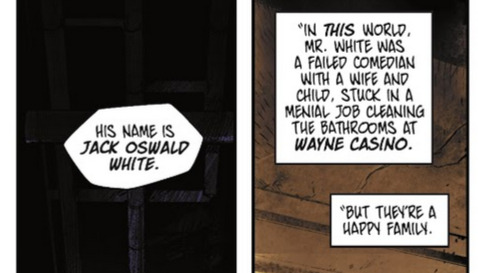
Flashpoint Beyond #5
I'm pretty sure we all agree that the only good part of that is "Jack". Don't know why the hell they went for "Oswald" (let Penguin have the monopoly on that goddammit!), but "White" is not that much of a surprise, it's just... a bit boring. Basically, Joker's had "White" attributed to him before in the Arkham games, he used it as an alias.
The fan-favorite (and my own, actually) name for Joker is actually "Jack Napier". It's got a long history... First used in Tim Burton's Batman (1989), it then got adopted by Batman: The Animated Series, The Batman (2004) and multiple other adaptations, like the Black Label Batman: White Knight comic-- which is just the most famous recently, but Joker's been named "Jack Napier" in so many other Elseworld and alternate universe DC comics. However, the name has popped up in comics closer to main continuity too. Joker himself used it as an alias in the New 52, in Red Hood and the Outsiders; but more importantly...
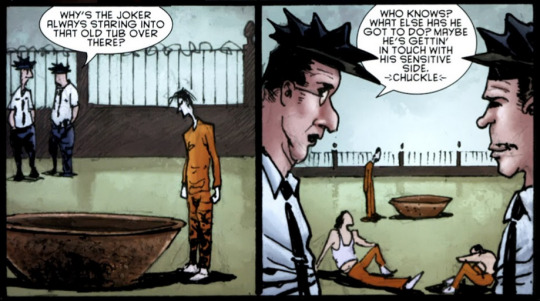
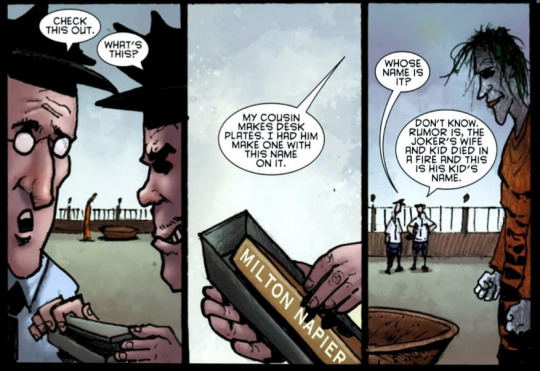
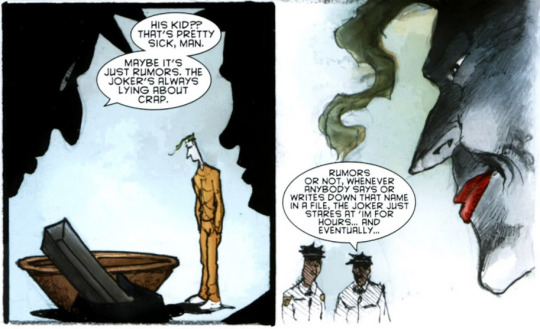
Arkham Asylum: Madness
Tough to say how canon this comic is, but it's heavily implied Joker's surname is "Napier". And since it's been canonized Joker's kid would've been a boy, "Milton" was probably his name (if you follow Falls the Shadow, my Joker-centric fic, you're probably familiar). But most recently, and having the most weight, they showed that the Joker equivalent of one of the Dark Multiverses was named "Jack Napier":
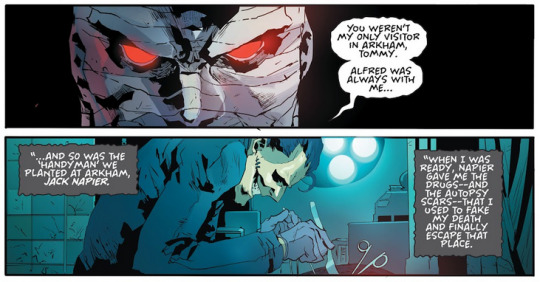
Tales of the Dark Multiverse -- Batman: Hush
So... it's a bit of a mess. It's been made official that his name was "Jack Oswald White" (maybe they want to do something with the initials JOW??), but the name people have been using for him for years is "Jack Napier". More generally though, you'll find that even comics that never give him a last name use "Jack" (like Batman: Gotham Knights #54, or Batman: Three Jokers, or the name of Jokester, the good Joker of Earth-3).
...And alright, I can't help myself. I'll go ahead and rant about a pet theory of mine, since I think Zdarsky intentionally tried to fit this all into an explanation. He tried to do something about Joker being people with different names and even different genders (like Martha Wayne) across worlds. But everything from here on is a spoiler for the main Batman run, so I'll put it all under the cut.
In case you're not familiar with the plot of The Bat-Man of Gotham, basically Bruce got thrown into another Universe in which Batman didn't exist. Here he found a guy called Darwin Halliday or Red Mask, who never became Joker, but wanted to. He'd glimpsed into the Multiverse with a chemical, and as a result created a machine that allowed one to travel the numerous Universes. In their final confrontation, Bruce and Red Mask both get hurled across the Multiverse by the machine, and here's an interesting panel from a world (clearly Burton's Batman movie world) Bruce encounters:

Batman (2016) #135
They have Bruce see his name, and the name "Jack Napier" on panel. Meanwhile, the "sane" Joker Bruce is chasing is named "Darwin Halliday". Then there's freaking "Jack Oswald White" for Prime Earth, an existing alternate called "Jack Napier" in a Dark Multiverse, and don't even get me started on freaking "Alby", another potential Joker name from Detective Comics (2016) #1000.
Bruce however, in Zdarsky's story and not only, only has himself. All the Universes he hops through have "Bruce Wayne" as the connection, even when Bruce isn't Batman (like in Batman Beyond). Is Bruce the only one to be Batman? Of course not, different others have carried the mantle (like Dick Grayson, Jean-Paul Valley, Tim Drake, Damian Wayne, James Gordon etc.). But I'm not trying to refer to worlds in which Bruce Wayne was Batman and then something happened to him and he was succeeded/replaced; I'm trying to refer to worlds in which someone else became Batman from the start. Those are quite rare, but they almost always have a Wayne: Thomas Wayne, or Helena Wayne. Even Owlman, the "evil" counterpart, is Bruce's brother.
Of course, the connection linking the Bruce Waynes is meant to be there so that the "infection" of Zur-en-Arrh can take place across the Multiverse. But then how exactly is Red Mask finding each Universe to jump into, right? How is he connecting mentally to all the Jokers, if the Jokers are different people and not the same as for Bruce? Why is it that whenever a Wayne becomes a Batman, someone becomes a Joker? Well...
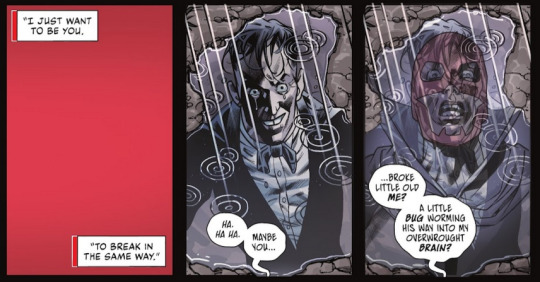

Batman (2016) #135
So. Red Mask was following Batman, the one who's existence directly lead to Jack going insane and becoming Joker. Wherever there was a Batman, Red Mask precipitated the creation of a Joker... who wasn't always the same person. Just the person who needed a "push" into becoming it, hence explaining why Joker is different individuals. "Joker" is pretty much the cosmic curse following Batman, his inevitable shadow. (Not only that, depending on the moment Red Mask arrived, he also brought back the existing Jokers from the dead or made them worse.)
Now. Do I like this explanation? Not really, I think it sucks to unravel Joker's character so much and take away all his mystery, all the cool alternate interpretations. Not only that, but this explanation essentially takes away agency from Joker's character and attributes it to freaking... Multiverse shenanigans. However, I did appreciate Zdarsky's effort to give the whole thing some meaning. You don't see that frequently in comics. And in a way, it's so insanely soulmates-as-a-curse for Batman and Joker. They're so tied together it's impossible to unravel them.
36 notes
·
View notes
Text
Notes Towards Anti-Authoritarian Victories: Distributed Resistance
TLDR: Distributed communities are a way to create a more equitable and sustainable society. We should decentralize and distribute power, resources, and decision-making. This comes from an emphasis on cooperation, restorative justice, and dismantling oppressive structures. Part of this process is honestly and earnestly exploring the role (and necessity) of the dialectic between violence and nonviolence in social change. There has to be a genuine embodiment of solidarity and diverse tactics. Two strategic frameworks for organizing resistance to explore and expand upon are encircling campaigns and the Fabian strategy. The overall goal is to build autonomous, resilient, and ethical movements. We have to challenge the status quo to create a more just world.
Distributed Communities
One of my main goals for how I interact with the world is to be a source of joy and hope for myself and others. Part of that is creating spaces for joy and hope. To create those spaces, we have to eradicate institutionalized spaces of despair and sadness. I’m not looking for a world without challenges…I’m just interested in finding realistic utopias, as opposed to the dystopic conditions we currently reside in. So, how do we get there, to a solarpunk world of dreams? First, let’s talk about where we are.
Centralization: The Anti-Life Equation
I’m not sure if you all are into comic books or anything like that, but I’ve always loved animated superhero shows and movies. Back when I was young, there was a DC show with a character called Darksied. His whole villainly motivation is to find the Anti-Life Equation. This is a math proof that essentially is meant to take away free will from living beings. Something about it is to prove the futility of living, therefore saying that people should just be controlled. Sound familiar?
Most people, especially from a Marxian tradition/understanding (so most sociologists and leftists), would say that this describes capitalism. Capitalism, as a reminder, is a system that functions most commonly off of two maxims: Private property rights (most notably towards the means of production, and as opposed to personal property) and wage labor. Many folks have argued, and I’d agree, that this system of withholding access to resources and goods across enforced property lines is bad, and stifles self-actualization. I want to go a bit further, though. I think that the underlying tendency that motivates capitalism, the imaginal cell spurring all of the negative emergent behaviors we see now is centralization.
Centralization is, as it sounds, about bringing “something” towards the center. In our case, that is power and access to resources and decisions. Centralization runs counter to nature. Though we apply our ideas of centralization onto nature, there is no true king of the jungle. Lions don’t “command” gazelle. And even if they did, us, as more conscious beings, can do better. Centralization is deterministic and linear instead of pluralistic and dynamic; it assumes that since people have differences that there have to be power distributions based on those differences. It’s Social Darwinism at its finest. Command-and-control social organization is pyramidal, and, no matter how “representative” the structure is, it inherently reinforces power distribution along lines of difference, creating and reifying social hierarchy.
Decentralization: A Light at the end of the Tunnel
Something that I and other folks struggle with is the pervasive nature of centralization. If it sucks for most people, as we know, then why is the entire world’s levers of power and influence pointed towards that? It seems like it has to be this way, otherwise we would be doing something else, right? Sadly, no. We, as people, are very susceptible to the systems that we interact with. We all live under centralizing systems of domination, coercion, and oppression, so our version of reality is warped by those experiences. But, just because we’re in a bad situation, doesn’t mean things have to stay that way. We’ve grown around these systems, and while they shape our thinking, they also create the fertile ground for their undoing. Subjects tend to not enjoy subjugation.
Decentralization is the antithesis of centralization. Decentralizing radically reorients power and access from a competitive, zero sum game, to a cooperative game. Even if you like competition, and you think it’s a necessary part of human nature (which it isn’t), we’re way past the point where stuff like that is useful. That’s assuming that it ever was, which I am skeptical about. The dog eat dog mentality, if nothing else, is destroying the Earth for profit. That alone, since we all need a functioning biosphere to…function, should be a searing indictment of the logics that underscore nation-states and capitalism.
By operating in a decentralized way, where we reorient our organizations to have power flow from the bottom up, we can enable more agile and resilient communities. It’ll not only give people more power to steer their lives (as opposed to hoping their boss or representative government official is a “nice guy”), but will allow society to continue existing, albeit in a new form.
Distribution: A Strong Network Flexes its Muscles
Decentralization is great, but if we’re not careful, it can just become like ancient times, where little city states have conflicts with each other, acting as little centralized pockets of power, even though they don’t have as much power over society as a whole. We want to be able to have connections with other communities and parts of society, without resorting to domination, coercion, and oppression. This can happen through distributing power across the network of communities, focusing on the goal of giving each individual the maximum autonomy in their lives. It looks like this: each person can live their life however they want, as long as it doesn’t impede others from doing the same. The same can be said on every level, from the block, to the neighborhood, to the city, and beyond.
This necessitates cooperation, as no one can provide all of their needs and wants by themselves. It also necessitates being militantly against domination, oppression, and coercion…people who are looking to cause harm do not get to claim that they are practicing autonomy. We have to do the hard work of practicing restorative and transformative justice. When people violate the autonomy of others, there has to be a victim-led response process, with a goal towards healing the victim, and supporting the betterment of the perpetrator if possible.
How we get there
Now, I haven’t gone in a ton of depth, since I don’t want to be super prescriptive as to what this new space could look like. That might leave a lot to be desired, in terms of a framework from how to get from here (a crumbling, decaying society that is looking to centralize more before it implodes) to there (a decentralized-distributed society where everyone’s needs and wants are met in an ecologically and socially harmonious way). My short answer is…power distribution. If we use this idea as an imaginal cell in our process and as the road on which we travel, we have a chance to create a situation where we can get the benefits of the olden days of city states (if you don’t like a place, you could just dip!), and most of the benefits of modern society, but spread out to each person. We probably won’t be able to see the levels of luxury of billionaires, or maybe even the lower end of the capitalist class, but we will all have a much, much better shot of living our lives in an actualizing way. Who knows what we can discover about ourselves in that kind of space?
Distribution as resilience
One of the great things about moving power away from central nodes is that it makes the system more resilient! A great example would be power grids. Imagine if your power grid for your town or city was centralized in one big plant, and everything was powered from there. If someone wanted to destroy your city’s electricity, they would just have to be able to take out the hub. Then, your city is blacked out, and there’s not a lot of ways to get that kind of critical infrastructure back.
Decentralization is a step better, but it can repeat the same things on a smaller scale. The most resilient option is for there to be a distribution of power generation (in the most sustainable way possible). We should always tend towards distribution—as much as reality would allow us.
What should be distributed, what should be decentralized?
Going back to the question of how we get from here to there, we have to face the reality that social change movements face repression from the status quo. Also, given the history of these movements, there are a lot of cases of co-option, and an incomplete version of the goal. In other words, we may not have the chance to prefigure the world we want to build before it is threatened by the old world. So, how do we uphold our values, while being strong enough to survive?
An important thing is to see this for what it is, a conflict. We have to engage as if we are facing an enemy, because we are. We also have to realize that, especially in a centralizing structure, our ire, in general, should not be for the foot soldiers but for structures and ideologies. We have a chance to win people over. It’s a lot harder for folks who are benefiting from the machine. This is not to say that we don’t acknowledge the harm that they cause. I mean to point out that if we get stuck in conflict with oppressive people and we don’t attack oppressive structures, we lose out on the ability to get decisive victories.
Another important piece is to not be dogmatic. We have to figure out our foundational principles and values, be honest about what we’re doing, and work hard to ensure we orient around short term gains that lead to long term successes, rather than quick fixes that endanger our progress in the long run. We want to know what works, but not be married to something. By thinking systemically, we can approach things in a diversity of effective tactics. This may mean that we occupy multiple parts of the centralization-distribution spectrum, depending on the area of focus.
In general, the more clandestine the operation, the more distributed it should be. Clandestine operations tend to be centralizing, so if we approach them from the opposite end of the spectrum we could potentially avoid the pitfalls. We also probably should never tend towards centralization, because that is a surefire way to destroy anything we create. Powermongers should just go work in the mainstream system if that’s their desire. Places where power tends to centralize, we should distribute, while being open to and welcoming of decentralization where it makes sense. An example could be: instead of every household having a personal car and coordinating sharing with each other (distributed), we could have car libraries that people check cars out from (decentralized). The most important thing to remember with any initiative that the goal is to make sure that power is not centralizing, even if there is a central place where resources exist.
Distributed Resistance
Violence
I want to switch gears and lean more into a side of world-change that people either knee jerk towards (”capital R” revolution) or away from (3.5% nonviolent resistance to social change nonsense). Let’s talk about violence.
Violence, as the state defines it, is something like physical force used to damage or destroy someone or something. That seems…reasonable, maybe, but let’s go a little bit deeper. Is it violent to commit non-physical harm, such as repeated verbal accosting? Is it violence to commit physical harm, when it’s on a time delay? It’s easy to point out immediate violence, like punching someone or burning something. It’s a lot harder when it’s a company putting carbon in the air, causing respiratory issues hundreds of miles away, the symptoms of which don’t show until years after the factory shut down. What about self-defense? How do we define that? Can violence be justified? Should justified violence even be labeled as violence?
There are a lot of questions to answer, but one thing is clear—a diversity of tactics is important. There also has to be solidarity. MLK and Malcom X understood how important each other’s tactics were to the success of the movement as a whole. Even if they didn’t reach the heights of their desires, that is an important lesson we can take away. If we act like nonviolence is unimportant, or act like “violence” is too far no matter what (like saying that hitting a nazi makes you no better), it makes our movements weaker. Like any tactic, it should be used tactically, not wantonly. We shouldn’t encourage fighting if its very unlikely to win (unless we have no other choice), and we shouldn’t encourage pacifism because of some short-sighted and self-defeating moral high-grounding.
An Occupying Force
A way that helps me think of our situation as people who want to help bring about new paradigms that directly conflict of the prevailing ones is framing it as if we are under military occupation. I mean, that’s basically the primary function of the state…that monopoly on violence. In my view, framing it like this makes a lot of the tactical orientation that I was discussing before make sense. When you are an occupied community, you very clearly see the subjugation that’s taking place. How “nice” your occupiers are is of little import; the fact that they’re there is transgression enough. Since we don’t have access to the “legitimate” flows of power (and if we did, we couldn’t use them to liberatory ends), we have to think differently. This is where operating as guerrillas comes in.
OODA Loop
Guerrillas are small groups that fight asymmetrically against a more powerful opponent. With us being tiny right now, it’s worthwhile to figure out how to fight in a way that makes our weaknesses into strengths. One method into this is the OODA loop. OODA stands for observe, orient, decide, and act. It’s a method for making strategic decisions in an iterative way. We observe our surrounding, circumstances, and current data. We then orient ourselves to our situation, making judgements based on that information. We decide what to do based on those judgements, and then we act upon those decisions, constantly iterating to make new decisions. The size and structure of decentralized and distributed organizations allows for iteration to happen more quickly, leading to an advantage over slower centralized structures.
Generally, the path I see to success is through operating via a distributed model of autonomous units, coordinating only when necessary, while also keeping the information network alive as is pertinent, and an alignment on vision and values. By any means necessary, but not all means. Especially if the group is operating as a singular organization, a la the ELF or ALF, ideally there would not be people that do tactics that violate that maxim. Means-ends unity is how we create the world we want. We can’t get liberation by exuding oppression.
Formations for Resistance
Before I leave, I want to list a couple strategic frameworks for organizing. The ones I’ll focus on are:
Encircling (i’ve discussed this in another post)
Fabian Strategy and Ethical Guerilla Warfare
Encircling
Encircling is when you surround an enemy in a way that doesn’t allow them to escape. You leave them two options: surrender or defeat. My conception of how this relates to organizing is that you take an issue that you’re trying to respond to (usually a system of oppression), and you encircle it with campaigns running in parallel. A campaign is like a series of actions/tactics, employed over a period of time. Since systems of oppression are…systemic, you would take a systems approach. You would work cross-functionally, looking for leverage points to exploit, and exploit those. My basic outline is that you’d have a campaign that starts off very non-confrontational, making appeals to the system of authority, and as that doesn’t yield “capital S” success (you can’t vote in socialism or decentralization), you ratchet up the confrontation, though only to the level that you can handle. It acts as a radicalization pipeline, strengthened by the results of the other campaigns. There would also be an extreme campaign, where folks are doing as confrontational of actions as they are willing to do. The rest of the campaigns would be in the middle, where they are relatively confrontational, moving towards heightened confrontation. Everything is moving into a more militant direction, where people are learning their power.
Fabian Strategy and Ethical Guerrillas
The Fabian strategy gets its name from Quintus Fabius Maximus Verrucosus, a dictator of Rome. His army was fighting against the much more well-equipped army of Carthage, so he opted for fighting a war of attrition. This sounds a lot like the situation social movements are in. It can be easy to think we have to fight might with might, but it’s a senseless and undesirable approach to try to outgun the state. We can use a guerilla orientation to organize in ways that highlight our strengths while exploiting their weaknesses. Building on this strategy will allow us to grow our movements and continue to fight, while simultaneously making it harder to put the movement down.
I also advocate for an ethical approach to this fight. By any means necessary, but not by all means available. There are certain actions that won’t yield us the results we want, and there are other actions that can only be useful in concert with other actions and campaigns. Broadly speaking, we want to minimize the harm caused to folks while maximizing the disruptions to the status quo. Here are some ways we can do this, some of which intersects and overlaps with the encircling framework:
Focus on grassroots organizing and building community power from the ground up. We have to think like stewards and coordinators rather than leaders; our strength comes not from a being a tiny centralized group, but an autonomous network of agents.
We build up our capacity, by creating multiple levels of engagement into the movement. we can combine non-confrontational tactics where we gradually increase disruption as support grows with giving support to more militant segments. This leads to a continual, dynamic (see nonlinear) process of education, advocacy, construction, and disruption.
Think about how to disrupt the status quo in a way that doesn’t target the oppressed. Instead of prevent public transportation or emergency vehicles from being able to travel, maybe focus on lavish events where some really terrible decisions are being made by oppressors at the expense of the oppressed. Actions can simultaneously be symbolic and direct.
Plan targets systemically. Keep the guillotine away. We don’t get our problems solved just by attacking elements within a system. If a leverage point ends up being a specific person… be very sure about understanding how to interact in a way that gets you the results that you want. Tactically and ethically, it becomes very hard to justify targeted attacks.
Uphold solidarity and mutual support among allies while respecting a diversity of tactics. Our analysis should be expansive enough to allow any tactics that could work within our ethical framework to be permissible, even if we personally don’t feel comfortable doing those tactics. As I said before: it’s not “anything goes”, its “we have to be willing to do anything we can that doesn’t violate our ends to achieve our means”.
If people can’t get behind your ideas, then your ideas need to be reexamined. Everyone has a horse in this race. People have to be able to understand that they have power as individuals and collectives, along with how to use it in non-coercive and non-oppressive ways. Meeting people where there at, showing up in real solidarity, and putting your ideas into practice goes way further than an isolated philosophical conversation.
We also have to keep fighting. This doesn’t mean that we are constantly ourselves fighting—through building distributed movements, we can take breaks and be sure that the network still functions. We won’t be able to create a new world in a single move, but through persistence, critical review, and intelligent strategy, we can grow and tend the seeds of change.
I hope this was interesting to ya. It’s a little different topically and format-wise than what I usually do, so let me know if this was interesting or useful. Solidarity forever 🙂
#economics#economy#econ#anti capitalists be like#neoliberal capitalism#late stage capitalism#anti capitalism#capitalism#activism#activist#direct action#solarpunks#solarpunk#praxis#socialism#sociology#social revolution#social justice#social relations#social ecology#organizing#complexity#resist#fight back
42 notes
·
View notes
Note
why dont you like the church of satan? im not a satan simp i promise i'm just genuinely curious because idk anything about them
i'm glad you asked! during my debate with the CoS simps on twitter i dug up a bunch of evidence of the Church of Satan's right-wing leanings, which was wasted on those losers because obviously they're not going to concede anything ever, but i'm glad to have a more receptive audience here.
so, to start with, the most well-known pieces of evidence relating to this are A: Anton Lavey said at one point that the CoS gives people "Ayn Rand with trappings" and B: there's a segment in the satanic bible called "the book of satan" which is outright copied from the proto-fascist philosophical tract "Might is Right", written by Ragnar Redbeard.
now, apparently CoS simps have taken it upon themselves to go around bothering anyone who brings this up, arguing that Anton Lavey only said that thing about Ayn Rand once so it probably doesn't mean anything (i am skeptical that he did only say this once but i haven't been able to find smoking gun evidence of him saying it other times) and the parts which copy from Ragnar Redbeard directly are only a few pages out of the satanic bible so, again, it probably doesn't mean anything. (ignoring that the influence of "Might it Right" is woven throughout the entirety of Anton's work, hardly limited to the direct quotes.)
so, to prepare my readers for if they get hassled by some CoS loser for stating the obviously correct fact that the CoS is right-wing, here's some more evidence to that effect, under a cut because i am merciful and this is going to get very long and very ugly.
here's Boyd Rice, then a major figure in the Church of Satan, saying that the principle of satanism is "let the master be the master and the slave be the slave, and never the two shall meet." this was in the documentary "Speak of the Devil", created by Nick Bougas, also a prominent figure in the CoS at the time. Nick Bougas is more well known by his nom de plume "A Wyatt Mann", aka the guy who drew those old nazi comics that became memes ("le happy merchant" etc).
here's some quotes from the official website of the CoS:
Satanists see the social structure of humanity as being stratified, thus each person reaches a level commensurate with the development (or lack thereof) of their natural talents. The principle of the survival of the strong is advocated on all levels of society, from allowing an individual to stand or fall, to even letting those nations that cannot handle themselves take the consequences of this inability. Any assistance on all levels will be on a “quid pro quo” basis. There would be a concommitant reduction in the world’s population as the weak are allowed to experience the consequences of social Darwinism. Thus has nature always acted to cleanse and strengthen her children. This is harsh, but that is the way of the world. We embrace reality and do not try to transform it into some utopia that is contrary to the very fabric of existence. Practical application of this doctrine would see the complete cessation of the welfare system, an end to no-strings attached foreign aid and new programs to award and encourage gifted individuals in all fields to pursue personal excellence. A meritocracy will replace the practice of such injustices as affirmative action and other programs designed to punish the able and reward the undeserving.
Satanists also seek to enhance the laws of nature by concentrating on fostering the practice of eugenics.
but if you REALLY want to get into the ugly shit that the CoS has been promoting, here's some excerpts from the magazine "The Black Flame", which the CoS published throughout the late 80's and through the 90's:
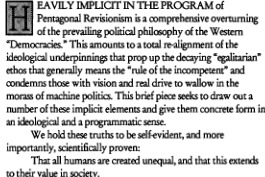


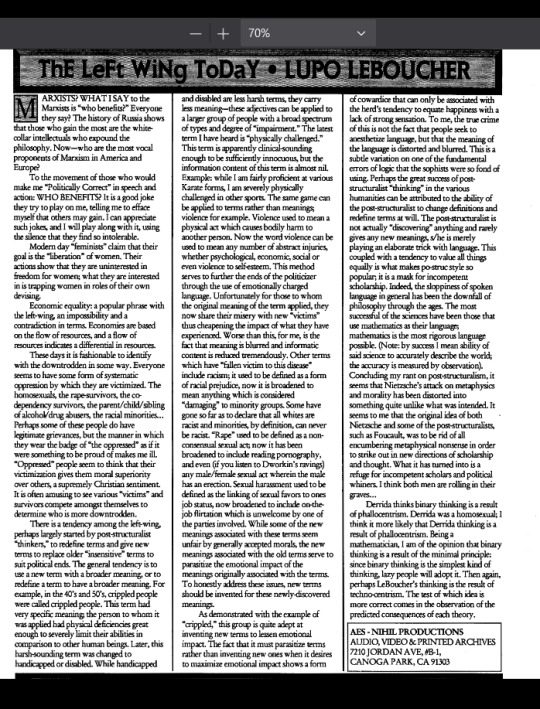
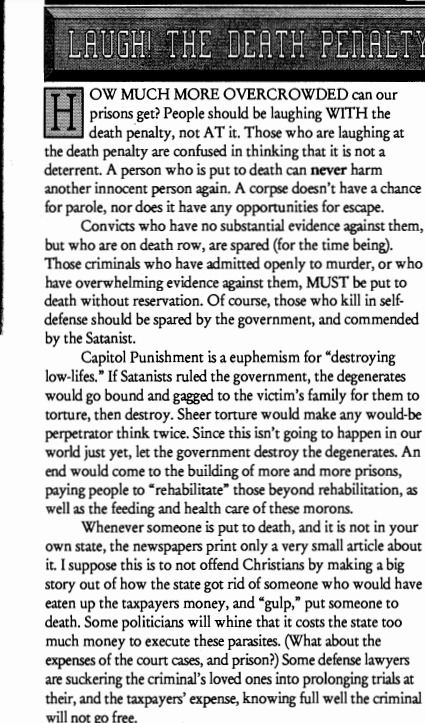




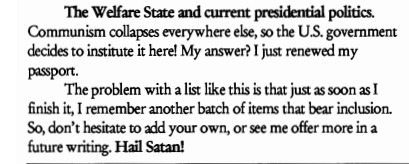

^that last one's from an interview with Lavey himself
and to bring things back around, here's another interview with Boyd Rice:
youtube
on the whole, while the CoS may present itself as an opponent of right-wing christianity, it's ultimately just controlled opposition, pushing largely the same right-wing agenda that the christian right was. it's funny that people never seemed to ask why christian conservatives like Bob Larson were always spending time interviewing, or being interviewed by, the Church of Satan if they were supposedly such mortal enemies.
173 notes
·
View notes
Text
The pop-culture urge to resurrect dinosaurs.
First of all, let me clear this, DINOSAURS ARENT EXTINCT. They are right there, maybe pooping around in your lawn or the non-veg meal you recently had. You just aren't aware of it. My previous blog was all about this and you can go check that out :)
So, if dinosaurs aren't extinct, then what's the point of bringing them back to life? More so... why make movies, write stories, draw comics and blah blah blah to actually resurrect them?! And this is what this blog is all about.

Birds, which are dinosaurs don't look like the dinosaurs you actually imagine it to be. Just wonder, what's the first thing that popped up in your mind, when you read the word 'dinosaur' in the very title itself. A giant beast, ferocious eyes, long necks maybe (those sauropods) and so on. No one did think about the chickens we eat, pigeons we shoo away or those beautiful kingfishers and parrots we admire. If you did, then... I think you are already smarter than me.
This is nothing, but the result of a constant impression about dinosaurs that pop-culture has fed to you, that your mind can't imagine anything else. More apt, you just can't think other than the Jurassic Park franchise if you are a 21st century kid like me!
Now hold on, this doesn't mean I am a Jurassic Park hater or this blog got grudges against it. I love that universe as much as you but the thing is, fact is fact. And, science in the end shouldn't be to please people, but to make people aware of the things they aren't aware of.
So... with a bit of reading and literature research, I actually dug into this matter deep enough to find a reason; that actually answers my question - Why pop-culture wants to resurrect dinosaurs?
Richard Owen coined the term dinosaur in the year 1841. Note, the Theory of Evolution and The Origin of Species was published by Darwin in the year of 1859, meaning the world dug out dinosaurs technically unaware of evolution and natural selection (pretty funny to me).
This makes sense as to why it got related to reptiles in the first place. Until 1860s there was pretty much no consensus to the fact that birds are related to dinosaurs. When Archeopteryx was initially discovered somewhen around 1860 it pretty much changed the course of Dinosaur paleobiology. Trust me, society didn't believe this in the first place. It took decades for the Dinosaur Renaissance to actually begin and thanks to Robert Baker's famous book Dinosaur Heresis in the 1970s, that gave dinosaurs the justice it had long due. So its pretty much okay to say that birds are dinosaurs came into the scientific consensus much much later than it was actually discovered (unfortunately this happens with most of the discoveries in Earth Sciences as a whole). Also, I would point to the discovery of more and more feathers in fossil specimens as the point where the relation between birds and dinosaurs were eventually confirmed.
Now dinosaurs came into the pop-culture scene in the 1850s with Charles Dicken's Bleak House. Yeah, a decade before Archeopteryx was dug out and Origin of Species was published. Movies first depicted dinosaurs as pretty lovable creatures. Classic example being the animated, Gertie - The Dinosaur (by Winsor McCay) which released as a silent film in 1914.
Soon after, it didn't take long for the lovable dinosaurs to turn into horrifying beasts. DW Griffith in his 1914's Brute Force silent film depicted Dinosaurs as ferocious monsters who haunted cavemen. Also establishing the early fiction, that early humans and dinosaurs coexisted together. This, a devastating scientific hoax (sugar coated as fiction), remained for quiet some time. You might have seen the famous cartoon series - The Flintstones, yup! if you were a fan of it like me, then you relate to what I am saying.
Steven Spielberg made Jurassic Park much later. Already a lot had been done about dinosaurs in the television and big screens. He legit hired paleontologists as scientific advisors for his films, which is why many things were even scientifically correct in the Jurassic Park film series, but at the end he was a film director to appease people and deliver box-office hits. He already knew what people wanted from dinosaurs. Hardly few will remember that the film actually says that birds came from dinosaurs in the very beginning. Instead, what you remember is just them chasing humans and destroying things. Unfortunate, but that's the reality.
Even today, its hard to imagine any film, story or comic that portrays dinosaurs as birds. They are the modern day dinosaurs! You have it all around. But you aren't satisfied with it and so you need movies that bring the typical dinosaur to life with the help of special effects to satisfy your soul. So yeah, if we as common people accept the fact that birds are dinosaurs then may be resurrection of dinosaurs will reduce to a lot extent in your screens and scientifically accurate stuffs will be fed to you :)
So, this is it for this blog. To be honest, while writing this I realized that I started loving these creatures because of pop-culture only :) no matter how scientifically inaccurate it was. I mean, this does become an irony. At one side of the spectrum it is to be blamed, but on the other it did make these creatures popular isn't it? Maybe I should cover this in my next blog hehe, so stay tuned!
For the love of Earth Science :D Byeee
Oh yes!!! Do check out my previous blog
thank you.
Used Image Souce - Youtube video titled 'The Flintstones | I Dare Ya!'
#earth#geology#science#dinosaur#museums#paleontology#jurassic park#jurassic world#comics#pop culture
14 notes
·
View notes
Text
》pinned!!! 💥🗯
★ hi call me darwin ! i am a genderqueer lesbian . 17 yo 👍creeps weirdos dni

☆ i enjoy/post about/draw warrior cats (canon, ocs, etc.), my ocs, jrwi prime defenders, mlp;fim, she-ra, shave your head and drop-out. lyrics too. sometimes i go through phases of other media im autism about all of them !
☆ check out my clangen blog ^____^ im developing silly characters
☆ realized i dont have my design blog here oops
★ i dont have a carrd or anything yet i need to remake shit.... i crawled over here from twitter..
^ that being said if u want my other socials just ask ! but i only talk to mutuals/friends really (people are scary)
my art tagged as either #my art or #darwin art ... i need to find all my art posts and tag them correctly.. important normal autism posts tagged as #darwin faves. non art/etc. posts tagged as #darwin talk
☆ ⬇️ more info like art / sonas + my blorbos in read more ⬇️ okk byee
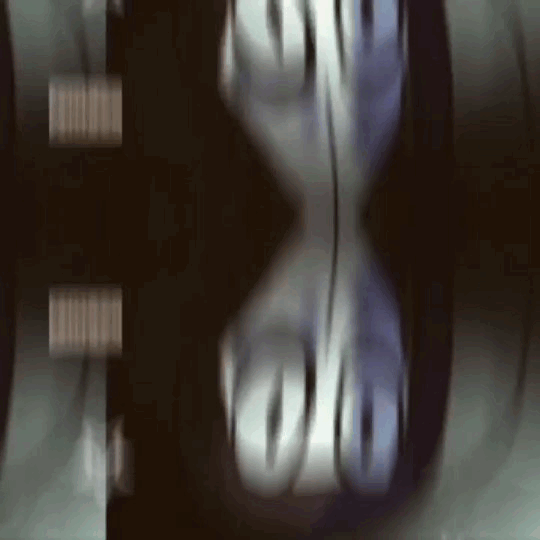
》 public? main? sona ⬇️ ⬇️ ⬇️

》 secondary-ish sonas ⬇️ ⬇️ ⬇️


》 my blorbos (normal characters) 💥💥💥




i want more images here but tumblr has a limit ...sniffle..... heres a blorbos list (in order of media)
hollyleaf, talltail, sleekwhisker + needletail, rowanclaw + tawnypelt, rileypool, roxie richter (spto), catra, ruby + sapphire (su), amythest (su), peridot (su), rainbow dash, all the cutiemark crusaders, sugar + lola (drop-out comic), kim (fresh-meat comic), rigby (regular show), darwin (tawog) <- last 2 r just me
7 notes
·
View notes
Text
so i just rewatched Hunters (2020) on amazon over the weekend - little did i know that amazon had chopped up and reorganized the first season to make it over an hour shorter than it was originally
wish i'd realized it sooner cuz a lot of good scenes were removed, maybe not plot important but they emphasized the point of a show where the discussion is Nazis Are Still Alive and Well. but anyway. for anyone who wants to know what all was cut here's an incomplete list of everything i noticed as i skimmed through the original version of the show today:
ep 1:
jonah thinking about college letters/looking at carol across the street before ruth gets shot
travis introduction scene
nasa nazi lady choking on her food, stripping in the bathroom
jonah & friends looking at girls on the beach
meyer talking about chava and the human chessboard scene
jonah eating the soup and yelling that its not his safta's soup
some dialogue removed from meyers speech to jonah at the end
ep 2:
the whole team introduction scene??? with all the comic book-y styles
"im tired im hungry im in fucking florida" millie scene
holstedder holocaust flashbacks were completely removed?
lonny saying he'd fuck ruth if she was younger and that everyone scares him, jonah mentioning cheeks and bootyhole to him
movie opening changed to mix with team introduction scene
scene with holstedder at the piano felt very different
meyer picking up the phone
how many nazis were killed in nuremberg
maria introduction scene
biff and tobias phone call
schidler corp nazi writing July 13 on a map
ep 3:
ruth first night in the camps flashback was shortened significantly
lonny pissing his name on the ground
millie and maria scene w/ travis watching them (that acknowledges sommers)
eva talking to nazi employees, "darwin's offspring"
Know This Now: How To Find A Nazi
"no one wants to be robin" "robin's got it made" conversation. "there's nothing wrong with wanting to stay alive"
stayin alive boardwalk scene where jonah sees young ruth
bootyhole and jonah couch conversation
joe and roxy hand scene and conversation extended
some travis stalking millie scenes were removed
"homegirl is a jew"
eva talking about biff's weapon, then travis and eva phone call where he reports heinz' death. a bunch of lines were cut. including "we've got friends in the FBI"
"ruth chose the darkness" mindy @ jonah
lonny and harriet scene in the restaurant
ep 4:
travis looking at photos in jonahs bed
wolf/ruth conversation lines cut
a bit of harriet & contact man's scene cut
lines from murray and bank nazi were cut, criticism of meyer's character
"compensation from maryanne's family is prepared" money scene with tobias
lonny harassing the bank cops
millie/maria i love you scene
meyer gives jonah the ring
ep 5:
"i don't look that jewish" "you? jew." lonny and jonah scene
tilda sauer presentation and information
jonah being terrible to carol
lonny on the phone with his agent
some dialogue between biff and juanita
ep 6:
some of harriet's flashbacks were cut, small scenes
some dialogue between biff and juanita
ep 7:
some of joe's traumatic share time story was cut
the slinky on una's stairs
music box cipher with the lullaby to get the code
joe: "hi. you're little." @ roxy's daughter, lingering looks between joe and roxy
lonny on the ground bleeding
ep 8:
travis arguing back at eva
jonah apologizing to mindy
Game Show Sequence - Why Does Everyone Hate the Jews?
ep 9:
US tribunal was reshot as a serious flashback rather than an old timey TV screening, also many lines were cut. "yup, that shit really happened!"
carol finding jonah's college acceptance letters
lonny and harriet talking about lonny's dad
jonah's friends seeing him drive away with the hunters and discuss talking to the cops
biff and millie talking
travis drinking eva's blood milk
big soundtrack change while lonny's sneaking into the electrical part of the factory
lonny explaining his fake bomb
ep 10:
harriet fishing meyer out of the water
millie talking to travis in jail and he talks about orange and a bunch of other lines were cut
meyer and ruth flashbacks were shortened i think
travis' parents coming to see him in prison and then he asks for a jew lawyer
some of travis' conversation with the lawyer was cut
5 notes
·
View notes
Note
the echidna soultouch thing is SO funny since LITERALLY before its even mentioned there is a hedgehog echidna couple so its already disproven before its introduced. although js joining knuckles in the beginning was said to be bc of the soultouch but i think its more of a retcon. and that would actually lend for cool shit if the soultouch was framed as racist comphet weak mind control but. it fucking wasnt so what was the point. also the fact its echidna only but the echidnas were only seperated by their technological prowess implies that some racist echidna just mutated all of angel island's echidnas. which i guess would make sense bc then the lost tribe and albilon echidnas wouldnt have soultouch
when js and knux first met there was some shit about being drawn to each other and not knowing why which was i think implying soultouch but i only picked up on that cause i already knew what soultouch was. locke says that the reason they evolved for soultouch is cause echidnas develop the logic sides of their brains more than other parts so they need some genetic Thing to make them find partners. which is like yeah ToT ok so echidnas are just too developed biologically to be in relationships w other mobians? ok ?? idefk this shit is so goddamn stupid why did he need to write social darwinism into his dumb fucking spinoff comic
12 notes
·
View notes
Text
Finding Darwin has Updated!

You can read the rest of the comic here!
#finding darwin clark#finding darwin#webcomic#comic#art#comics#webcomics#clark#finding darwin comic#kira#finding darwin kira
11 notes
·
View notes
Text
Finding Darwin pg 34

Read the whole thing at finding-darwin/webcomic.ws
13 notes
·
View notes
Photo
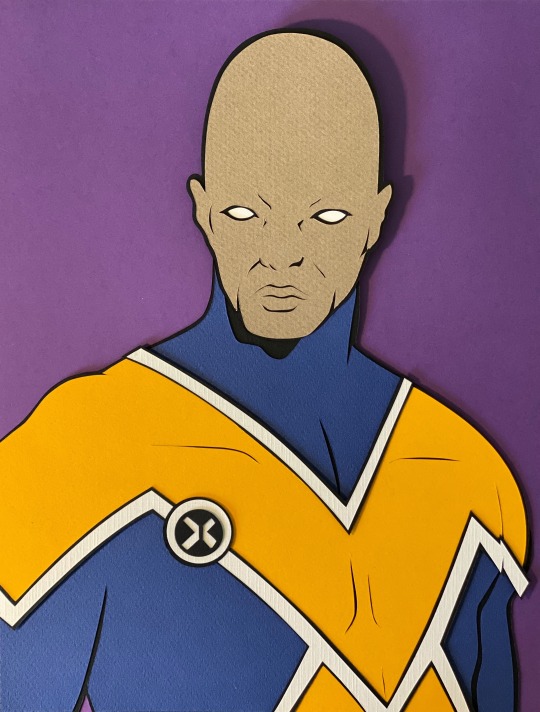
365 Marvel Comics Paper Cut-Out SuperHeroes - One Hero, Every Day, All Year…
August 22nd - Darwin
Armando Muñoz’s Mutant abilities and attributes were evident from birth. As a child, he came to realize his powers enables him to survive in any element and under any condition. His physique is in a constant state of evolving, always best adjusting to factors in his environment.
Under the alias of ‘Darwin’ Armando was recruited by Moira MacTaggert as part of a secondary team of X-Men tasked with rescuing the original team after they had become lost on the living island of Krakoa. This second team fared poorly in their mission and were all apparently killed. Darwin, however, managed to survive by becoming a sentient energy. He was rescued and revived years later by a new team of X-Men and soon thereafter joined the X-Men in a mission that took them to the cosmos where they became involved in the War of Kings/Realm of Kings events.
Upon returning home, Darwin stepped away from the X-men and served instead as a member of Jaimie Maddrox’s X-Factor Investigations firm. During this time, Darwin developed a crush on his teammate, Monet, but was too shy to tell her about his feelings.
An adventure with X-Factor saw the team facing off against Hela the Asgardian deity of the underworld. Darwin received from Hela her alleged ‘death touch’ and the process through which his powers adjusted to endure the assault caused him to absorb and take on Hela’s powers. He had a hard time coping with the experience and he left the team and endured a prophetic hallucination where he came to believe that he must kill the werewolf lord, Tier, in order to prevent a war between hell and earth.
Compelled by forces beyond his understanding, Darwin continued to track Tier to New York, leading to altercations with The Werewolf by Night as well as Darwin’s former allies amongst X-Factor. Darwin discovered that Tier is Wolfsbane’s son and he was unable to bring himself to kill him. All this precipitated the Hell on Earth War event and Darwin fought side by side with X-Factor to fend off the Hell Lords.
Following these events, Darwin was separated from the others and traveled back to Las Vegas to find Hela so to try to force her to fix him. While searching for Hela, Darwin encountered a recently resurrected Monet. The pair had a one-night stand. Afterward, Hela found Darwin, but he refused her help.
To what extent Darwin has been able to free himself from the effects of having absorbed Hela’s powers remains to be seen. Darwin has recently relocated to the Mutant nation of Krakoa from where he has embarked on a mission to learn the secrets of the Children of The Vault.
A version of Darwin featured in the Fox Films move, X-Men: First Class where his character was portrayed by actor Edi Gathegi. The hero first appeared in the pages of X-Men: Deadly Genesis #2 (2005).
28 notes
·
View notes
Note
As someone who appears to have undergone their intellectual formation during the capital 'T' Theory era, closely associated with a chic and predominantly discursive radicalism (the left of the left of the left), how did you begin to grow increasingly skeptical of this milieu and its orthodoxies? In my experience, most of those we now label as "theorycels" feel that abandoning this tradition would equate to a wasted life, especially given the extensive reading involved.
Thanks! It's a big question. In some ways I'm less skeptical of theory now than I've ever been (I assume you mean poststructuralist theory). I entered college with The Western Canon and Sexual Personae under my arm, so I began my tertiary education by being very wary of it. I've always had a dispositional dislike of theory as a literary style: the dogmatic tone coupled with the extreme abstraction, so that the law is being laid down, except that you don't quite know what it says. Even Foucault complained of Derrida's style that it represented "the terrorism of obscurantism." I hated the smug way theory was used in English departments to discredit literature as a machinic combination of preexisting ideologemes, to banish the sense of ineffable inspiration and world-transforming mission so many major writers themselves have always testified to—to discredit literature as one discourse among others, rather than the queen of the discourses, which it is (and if you can't say it is in an English department, where the hell can you say it?).
By the time I entered graduate school, though, theory was on the way out in English departments, to be replaced by various forms of historicism and other kinds of sociological and reductive "cultural materialist" approaches and the digital humanities. These approaches are far more anti-literary than theory ever was—especially if you actually read theory's primary sources, figures like Barthes and Deleuze, and find out how much more romantic and psychedelic they actually are in contrast to their literal-minded, puritanical Anglo translators and redactors. At least theory understands, as historicism does not, that the inner plurality and polysemy of every major text guarantees that the text by definition exceeds, defies, transforms its context, including its past and its future.
Theory has always had a hostility to the state that infuriated Marxists—I take theory to be a late Cold War manifestation of anti-communism—and therefore it made a brave showing against the totalitarian technocracy of the pandemic era, so much so that at least one would-be technocrat wrote a whole book to denounce it (see the link to my review of The Revenge of the Real below). It can also furnish resources to scrutinize the claims of the identitarian left (cf. "Postmodernism Is Good, Actually"). (That it also helps us to criticize the biologism and Social Darwinism now so fashionable on and adjacent to the right today should go without saying.) Its bracing anti-humanism is refreshing in the face of the "therapeutic society." Michel Foucault would not advise us to "trust science" and might be skeptical that we can "have" a gender, and Jacques Lacan thinks our vaunted "trauma" stems from our induction into the order of language and that therefore there is no real treatment except to play with language.
It's still not my preferred reading material, though—too dry, too abstract (though no more or less than Hegel, Kant, Spinoza; a lot of people who don't like "theory" just don't like "philosophy," and I have my days, too). Paglia's critique of theory was entertainingly external, a stand-up comic's brutal mockery. But Bloom was friends with Derrida and de Man, so I take his criticism more seriously: that theory deadeningly codified the insights it plundered from imaginative literature, which it then turn around (resentfully) and attacked. Derrida was "French Joyce," said Bloom, and Foucault "French Shakespeare." I tried to make this very point in my doctoral dissertation:
The wager of this study is that such novel-theory has, in my view, mistaken its own genealogy. I particularly want to engage the skeptical tradition of novel-theory because I hope to substantiate the claim that its own posture of suspicion toward subjectivity is first articulated in and by the novel of Aestheticism, which will become the modernist novel proper. How, after all, can critics so astutely observe the operations of ideology if they do not claim some distance from its demands, just as Pater and Wilde did when they declared art autonomous from social claims? My argument about the Aestheticist novel as thinking form can be summarized as follows: by declaring its distance from apparatuses of state, church, and market, the novel under Aestheticism claims for itself a privileged vantage from which to produce critical knowledge about these institutions using its own procedures rather than relying tautologically on those of the hegemonic forces it contests. Furthermore, in developing those procedures, it reflects critically upon them too, becoming a recursive form of criticism that examines its own entanglement in the relations it criticizes. Because of this reflexivity, autonomous literature may be complicit with ideology but can never be fully identical to it. In short, the modern novel looks more like the kinds of bold, agential theory written by critics such as [D. A.] Miller and [Nancy] Armstrong than one would guess from reading their works.
Paglia's right, though, that it has no sense of nature and little sense of spirituality and is finally too impoverished a vision. I agree with D. H. Lawrence that the proper place for philosophy is probably the novel. We could talk about exceptions to all my criticisms—Foucault is lucid, Deleuze is wild, Barthes is novelistic—and overall I find the achievement of those thinkers, insofar as I understand it, to be mixed.
Some of my further thoughts on theory can be found in my essay on Foucault and my essay on Lyotard, while my attack on the tendencies that succeeded theory in literary studies and on the American left at large can be found in my essay on Franco Moretti and my essay on Benjamin Bratton. And you probably won't want to miss the chapter in my novel Portraits and Ashes where a company of academic critics spend pages debating the significance of an art installation before it turns out that the installation's purpose is to slaughter its audience—my horror-comedy version, perhaps, of art's superiority to theory.
4 notes
·
View notes
Text
pinned post for blog hygiene:
favorite 616 characters: alex summers, kwannon, john greycrow, quentin quire, maddie pryor, gabriel summers, larry trask
favorite XMCU characters: armando muñoz, alex summers, bobby drake, john allerdyce, romijn!mystique, mckellan!magneto, hank mccoy, angel salvadore
favorite comics ships: scoganjean, quevandie, crowhavlocke, alex/almost any man at all, crowlocke, alex/maddie (exclusively in an unhealthy way), gov. gen. howlett/hercules, hank/abigail (derogatory)
favorite XMCU ships: alex/darwin (otp), scogan(jean), allerdrake, alex/hank, first class polycule
favorite series (current): X-Men Red (Ewing/Caselli), Dark X-Men (Foxe/Scharf)
favorite stories/arcs (past): Inferno (1988), Havok & Wolverine: Meltdown (Simonsons/Williams/Muth), X-Treme X-Men (Pak/Segovia), Hellions (Wells/Segovia), X-Men #56-60 (Thomas/Adams)
characters against whom I am mildly to severely biased: charles in any incarnation (severe), 616!kurt wagner (mild to moderate), 616!hank mccoy (severe, except 60s/70s hank, who i love), abigail brand (severe)
stances on common wank/controversy topics: the marvel girl dress is fine; charles has no boundaries and has consistently been a creep since '63; wanda maximoff is a romani woman and lizzie should not have been cast as her; scott has no ass; jott and scemma are both great ships; madelyne can do whatever she wants to scott and especially jean, forever; the phoenix force is her own person
I'm also working on a project called Nothing Girls: The Case For A Transfeminine Havok in the Krakoan Era, but I've been working on it fairly steadily since 2021, so I have no idea when it'll be in post-worthy condition, but you'll find little thoughts I have about on this blog, and a poorly-kept journal of current efforts over at @nothinggirls, and scattered relevant screencaps at @queerhavok.
8 notes
·
View notes